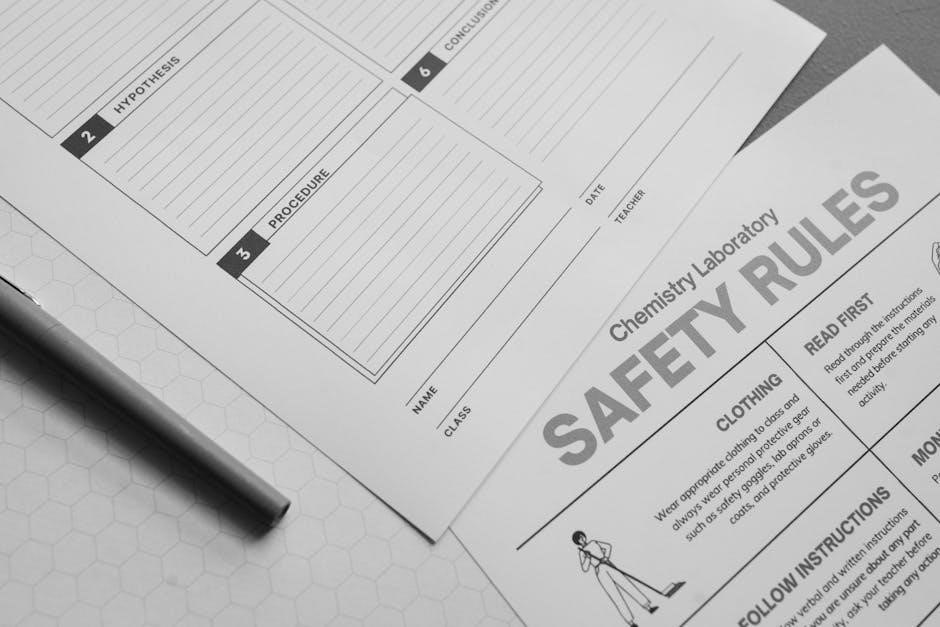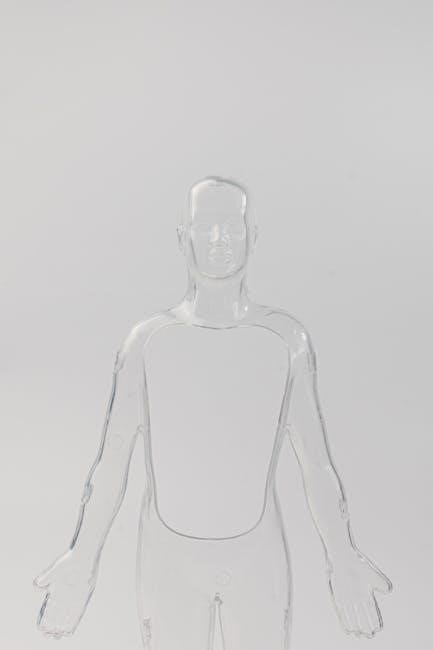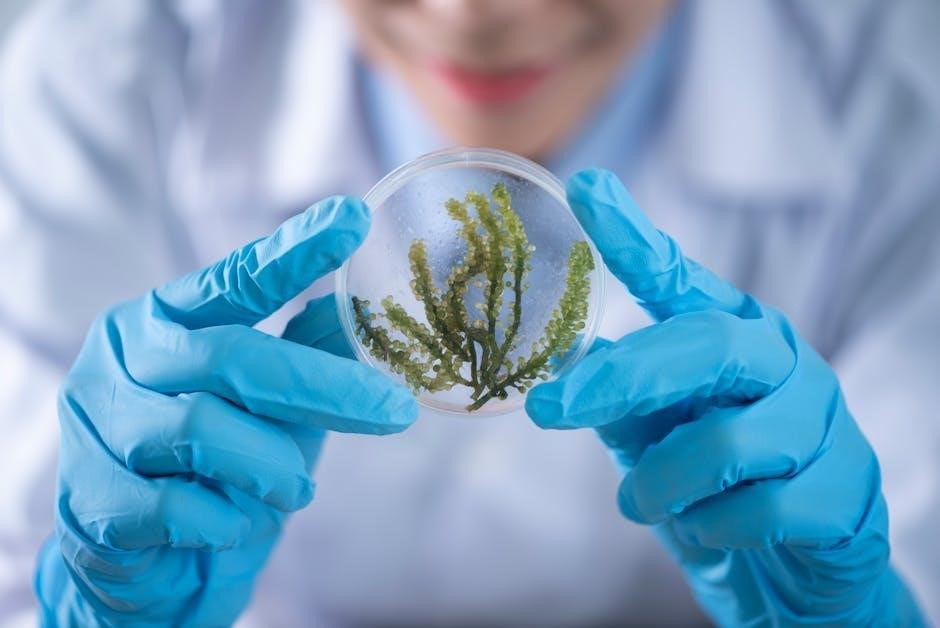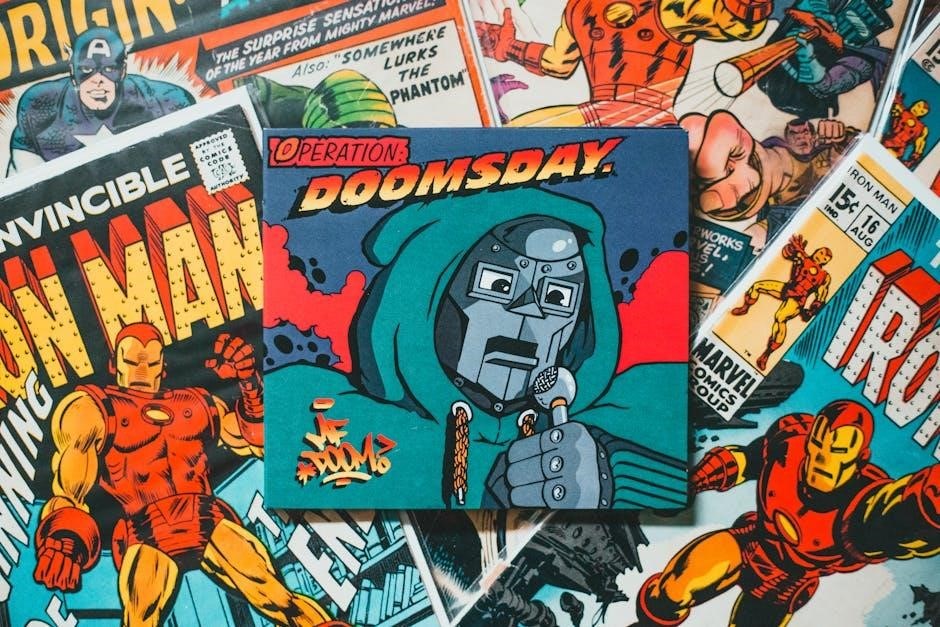A witty and engaging guide by Craig Criddle and Larry Gonick, this book simplifies complex chemistry concepts with humor and clarity, making learning fun for everyone.
Overview of the Book and Its Purpose
The Cartoon Guide to Chemistry is a unique blend of humor and science, designed to make complex chemistry concepts accessible to everyone. Through engaging cartoons and clear explanations, it covers topics from the basics of chemistry to advanced theories, providing a comprehensive understanding of the subject. The book aims to simplify learning, making it enjoyable and interactive for students and general readers alike.
Authors and Their Contributions to Science and Cartooning
Craig Criddle, a renowned scientist at Stanford University, and Larry Gonick, a celebrated cartoonist, collaborated to create this engaging guide. Criddle brings deep scientific expertise, while Gonick’s illustrations make complex concepts visually accessible. Their partnership uniquely blends science and art, ensuring the book is both informative and entertaining, making chemistry approachable for a broad audience.
Target Audience and Learning Benefits
The Cartoon Guide to Chemistry is designed for students, educators, and enthusiasts seeking an accessible introduction to chemistry. Its unique blend of visuals and humor demystifies complex topics, making it ideal for visual learners. The guide supports curriculum learning, enhances retention, and fosters a deeper appreciation for chemistry’s role in everyday life, encouraging engagement for readers of all ages and backgrounds.

History and Basics of Chemistry
Exploring chemistry’s rich history and foundational concepts, this guide simplifies complex ideas, making the subject accessible and engaging for learners of all levels.
Key Milestones in the Development of Chemistry
From ancient Greek alchemy to modern discoveries, chemistry’s journey is marked by pivotal moments like Mendeleev’s periodic table, the discovery of elements, and breakthroughs in molecular theory. These milestones, illustrated with humor, make complex history engaging and accessible, showing how chemistry evolved into a precise science.
Atoms, Elements, and Compounds: The Building Blocks
Atoms, the tiny building blocks of matter, combine to form elements and compounds. Through cartoons, the guide illustrates how elements like hydrogen and oxygen merge into water (H₂O), showcasing chemical composition. This visual approach simplifies the fundamentals, making abstract concepts like atomic structure and bonding engaging and easy to grasp for learners of all levels.
The Evolution of Chemical Thought and Theories
The Cartoon Guide to Chemistry traces the journey of chemical thought, from ancient theories to modern breakthroughs. It humorously illustrates how early concepts of elements and matter evolved into contemporary understanding. The book highlights key milestones, such as the discovery of atomic structure and the periodic table, while using cartoons to make complex theories like chemical bonding and thermodynamics accessible and engaging for all learners.

Atomic Structure and the Periodic Table
This section delves into the fundamentals of atomic structure, exploring electrons, protons, and neutrons. It humorously explains the periodic table’s organization, revealing trends and patterns in elements’ properties through engaging visuals and simple language.
Electrons, Protons, and Neutrons: The Fundamental Particles
The Cartoon Guide to Chemistry humorously explores the roles of electrons, protons, and neutrons, explaining how they form atoms. Electrons orbit the nucleus, while protons and neutrons reside within it. The book uses engaging visuals to illustrate how these particles determine an element’s identity and properties, making complex atomic structure accessible and enjoyable for learners of all levels.
Understanding Atomic Structure and Its Importance
The Cartoon Guide to Chemistry vividly explains atomic structure, using cartoons to make complex concepts engaging. It details how electrons, protons, and neutrons interact, emphasizing their role in forming elements and compounds. The guide underscores the importance of atomic structure in understanding chemical properties and reactions, making it fun and accessible for learners to grasp these fundamental principles of chemistry.
The Periodic Table: Organization and Trends
The Cartoon Guide to Chemistry uses engaging visuals to explain the periodic table’s organization, highlighting groups, periods, and key trends. It illustrates how elements are arranged by atomic structure and properties, making it easy to understand patterns in periodicity. The guide humorously breaks down complex trends, such as atomic size and reactivity, helping learners connect the table’s design to chemical behavior in a fun and memorable way.

Chemical Bonds and Reactions
This section humorously explores the fundamentals of chemical bonding and reactions, using cartoons to clarify concepts like ionic, covalent, and metallic bonds, and reaction mechanisms.
Types of Chemical Bonds: Ionic, Covalent, and Metallic
The Cartoon Guide to Chemistry humorously differentiates between ionic, covalent, and metallic bonds. Ionic bonds involve electron transfers, forming ions held by electrostatic forces. Covalent bonds share electrons, creating strong connections. Metallic bonds allow free-moving electrons, characteristic of metals. Each type is visually explained through engaging, easy-to-understand illustrations and relatable analogies, making complex concepts accessible and entertaining for learners of all levels.
Chemical Reactions: Synthesis, Decomposition, and More
The Cartoon Guide to Chemistry breaks down chemical reactions with clarity and humor. Synthesis reactions combine elements or compounds, while decomposition reverses the process. The guide uses engaging visuals and witty storytelling to explain reaction types, mechanisms, and importance of stoichiometry. By simplifying complex processes, it makes chemistry accessible and fun, ensuring learners grasp the fundamentals of chemical transformations effortlessly.
Reaction Stoichiometry and the Mole Concept
The Cartoon Guide to Chemistry simplifies stoichiometry and the mole concept through cartoons. It explains ratios of reactants and products, balancing equations, and conversions using moles. With humor and visuals, the guide demystifies concepts like limiting reagents and percent yield, making these essential tools for chemical calculations both understandable and memorable for students of all levels.

Thermodynamics and Energy
The Cartoon Guide to Chemistry humorously explores thermodynamics, covering energy types, entropy, and the laws of thermodynamics with clear, engaging visuals that simplify complex concepts.
The Cartoon Guide to Chemistry offers a fun and accessible explanation of thermodynamics, introducing the fundamental laws that govern energy transformation and transfer. Through engaging illustrations and simple analogies, the guide demystifies concepts like energy conservation, entropy, and the direction of spontaneous processes, making these principles easy to grasp for readers of all levels.
Heat, Entropy, and the Direction of Processes
The Cartoon Guide to Chemistry cleverly explains heat and entropy, illustrating how these concepts determine the direction of chemical and physical processes. Through humorous visuals and clear explanations, the guide explores the second law of thermodynamics, emphasizing entropy’s role in measuring disorder and predicting the spontaneity of natural processes.
Energetics of Chemical Reactions
The Cartoon Guide to Chemistry makes complex concepts like energy changes in reactions engaging and easy to grasp. Using humor and visuals, it explains endothermic and exothermic processes, highlighting how energy drives chemical reactions. The guide also explores activation energy and why reactions occur, offering a fun yet thorough understanding of chemical energetics for students and enthusiasts alike.

Solubility and Solutions
The Cartoon Guide to Chemistry humorously explains solubility principles, solvation, and concentration, using cartoons to make complex concepts like colligative properties engaging and easy to understand.
Principles of Solubility and Solvation
The Cartoon Guide to Chemistry humorously breaks down the principles of solubility, explaining how substances dissolve and interact in solutions. Through engaging cartoons, it illustrates solvation processes, highlighting how solutes interact with solvents at a molecular level. This section makes complex concepts like “like dissolves like” and solubility rules easy to grasp, ensuring a fun and educational experience for readers of all levels.
Concentration and Colligative Properties
In a fun and visual way, the Cartoon Guide explains how concentration affects solutions and introduces colligative properties like vapor pressure lowering and boiling point elevation. Through cartoons, it demonstrates how solute concentration impacts these properties, making abstract concepts like molarity and dilution easy to understand. The section also humorously highlights real-world applications, ensuring an engaging and memorable learning experience.
Acids, Bases, and pH in Solutions
The Cartoon Guide humorously illustrates the concepts of acids, bases, and pH, using engaging visuals to explain proton transfer, acid strength, and base behavior. It clarifies the pH scale with relatable analogies, making complex topics like strong vs. weak acids and buffer solutions easy to grasp. The section ensures learners understand these fundamental properties through an entertaining and accessible approach.
Applications of Chemistry in Everyday Life
Chemistry shapes daily life, from cooking to medicine, influencing household products, food safety, and environmental sustainability. It bridges science and practical solutions, enhancing our quality of life.
Chemistry in the Kitchen and Household
Chemistry is ever-present in cooking, cleaning, and household tasks. From baking reactions to detergent formulations, it explains how ingredients interact. Understanding chemical principles can enhance food safety, improve cleaning efficiency, and make daily routines more effective. The Cartoon Guide to Chemistry humorously illustrates these connections, showing how science shapes everyday life through simple, relatable examples and visuals.
Chemistry in Medicine and Pharmaceuticals
Chemistry is fundamental to medicine, driving drug development and understanding biochemistry. It explains how medications interact with the body, from molecular bonds to pharmacokinetics. The Cartoon Guide to Chemistry visually simplifies these processes, making complex concepts like drug design and disease mechanisms accessible. By linking chemistry to real-world health applications, it inspires a deeper appreciation for how science improves healthcare and saves lives through innovation.
Environmental Chemistry and Climate Change
Chemistry plays a vital role in understanding and addressing climate change. The Cartoon Guide to Chemistry highlights how chemical processes like carbon capture and greenhouse gas interactions impact the environment. It visually explains innovative solutions, such as Climeworks’ direct air capture technology, making complex environmental chemistry accessible. This section emphasizes the importance of chemistry in developing sustainable practices and combating global climate challenges through engaging visuals and humor.

Lab Safety and Experimental Techniques
Essential safety protocols and proper lab equipment usage are highlighted, ensuring a fun yet safe learning environment for chemistry experiments and hands-on activities.
Essential Safety Protocols in the Chemistry Lab
The Cartoon Guide to Chemistry emphasizes wearing goggles, gloves, and lab coats to protect against chemicals. Proper handling of substances, reading labels carefully, and ensuring good ventilation are stressed. Understanding emergency procedures, like evacuating the lab or using fire extinguishers, is crucial. These protocols ensure a safe environment, allowing learners to focus on experiments with confidence and curiosity, aligning with the book’s engaging and educational approach.
Basic Laboratory Equipment and Its Uses
The Cartoon Guide to Chemistry highlights essential lab tools like beakers, test tubes, and Bunsen burners. These instruments are vital for measuring, mixing, and heating substances. Microscopes and balances are also covered, emphasizing their roles in observation and precise measurements. The guide explains each tool’s function in a fun, visually engaging way, helping learners grasp their importance in conducting experiments safely and effectively.
Conducting Experiments: Tips and Best Practices
The Cartoon Guide to Chemistry offers practical advice for conducting experiments, emphasizing clear planning, precise measurements, and safe handling of materials. It highlights the importance of following lab protocols, wearing protective gear, and maintaining organized records. The guide also underscores the value of understanding chemical reactions and variables before starting, ensuring a smooth and safe experimental process with meaningful outcomes.

The Role of Visual Learning in Chemistry
The Cartoon Guide to Chemistry uses comics and humor to simplify complex concepts, making chemistry accessible and engaging for learners of all levels.
How Cartoons and Comics Enhance Understanding
Cartoons and comics simplify complex chemistry concepts through visual storytelling, making them engaging and easier to grasp. By combining humor with visuals, they break down intricate ideas into digestible parts, fostering better retention and understanding. This approach transforms abstract theories into relatable scenarios, helping learners visualize relationships between atoms, molecules, and reactions. The interactive nature of comics also encourages active thinking and problem-solving.
Using Visual Aids to Simplify Complex Concepts
Visual aids like cartoons and comics transform intricate chemistry concepts into vivid, easy-to-understand illustrations. By breaking down processes such as atomic structures and chemical reactions into clear, step-by-step visuals, these tools make learning accessible. The combination of images and concise text helps students grasp abstract ideas quickly, fostering a deeper understanding and engagement with the material. This visual approach enhances traditional teaching methods effectively.
Engaging Students Through Humor and Creativity
The Cartoon Guide to Chemistry captivates learners by infusing humor and creativity into complex topics. By presenting chemistry through relatable cartoons and witty narratives, it breaks down intimidating concepts into digestible, entertaining content. This approach not only fosters a deeper interest in chemistry but also makes the subject more accessible and memorable for students of all ages and educational backgrounds.

Future Directions in Chemistry
Emerging fields like carbon capture and renewable energy highlight chemistry’s role in addressing global challenges, inspiring future innovations and educational initiatives to nurture the next generation of chemists.
Emerging Fields and Innovations in Chemistry
Direct Air Capture (DAC) technology, pioneered by Climeworks, revolutionizes carbon removal, aiming to combat climate change. This innovation highlights chemistry’s role in sustainable solutions, alongside advancements in green energy and materials science, inspiring future breakthroughs and educational initiatives to address global challenges.
The Role of Chemistry in Addressing Global Challenges
Chemistry plays a vital role in tackling global issues like climate change and resource management. Innovations such as carbon capture technologies and sustainable energy solutions demonstrate chemistry’s potential to create a greener future. By addressing these challenges, chemistry inspires new generations to explore scientific solutions, fostering a better understanding of how science impacts everyday life and global sustainability.
Encouraging the Next Generation of Chemists
The Cartoon Guide to Chemistry inspires young minds by making complex concepts fun and accessible. Its engaging visuals and humor spark curiosity, showing how chemistry impacts real-world issues. By highlighting the relevance of chemistry in solving global challenges, the book motivates students to pursue STEM careers. Interactive learning and hands-on experiments further fuel their interest, shaping the next generation of scientists and thinkers.
The Cartoon Guide to Chemistry bridges microscopic and macroscopic concepts with humor and visuals, making complex ideas accessible and engaging for all learners.
Summarizing Key Concepts and Takeaways
The Cartoon Guide to Chemistry effectively simplifies complex concepts using humor and visuals, covering atomic structure, chemical bonds, and reactions. It bridges the gap between microscopic and macroscopic principles, making chemistry accessible to all learners. The book’s engaging approach ensures that even intricate ideas like thermodynamics and stoichiometry are presented in a clear, relatable manner, fostering a deeper understanding and appreciation of chemistry.
The Importance of Making Chemistry Accessible
Making chemistry accessible is crucial for fostering scientific literacy and curiosity. The Cartoon Guide to Chemistry achieves this by using humor and visuals, breaking down barriers to understanding. By presenting complex concepts in an engaging way, it encourages learners of all levels to explore and appreciate chemistry, emphasizing its relevance to everyday life and global challenges like climate change and sustainability.
Final Thoughts on Learning Chemistry Through Cartoons
Learning chemistry through cartoons offers a refreshing approach to education. The Cartoon Guide to Chemistry proves that humor and creativity can make complex concepts engaging. By blending visuals with clear explanations, it transforms daunting topics into enjoyable lessons. This method not only enhances understanding but also sparks interest, showing that chemistry can be both fun and accessible for everyone, regardless of their background.

Additional Resources for Further Learning
For deeper exploration, check out recommended books, online courses, and interactive tools. Join chemistry communities and forums to enhance your understanding and stay updated on the latest discoveries.
Recommended Books and Online Courses
Explore additional resources like The Cartoon Guide to Physics and Genetics for a comprehensive understanding. Online platforms like Coursera and Khan Academy offer detailed chemistry courses. Supplement your learning with interactive tools and educational websites that provide visual aids and practice problems to reinforce concepts discussed in the guide.
Interactive Tools and Educational Websites
Enhance your learning with tools like PhET simulations and ChemCollective, offering interactive labs and games. Websites such as Khan Academy and Crash Course provide video tutorials and quizzes. These resources complement the Cartoon Guide, making complex concepts engaging and accessible through visual and hands-on experiences.
Communities and Forums for Chemistry Enthusiasts
Join online forums like Reddit’s r/chemistry or Stack Exchange’s Chemistry community to engage with experts and enthusiasts. These platforms offer discussions, problem-solving, and shared resources. Social media groups dedicated to chemistry also provide interactive learning opportunities, fostering collaboration and knowledge exchange among learners and professionals alike.
